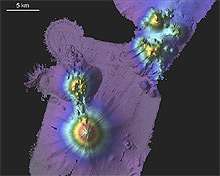Submerged volcanoes pose tsunami threat

One of the world’s most active volcanic areas is a relatively unknown part of the seabed between New Zealand and Tonga, and could trigger a devastating tsunami at any moment, ANU geologist Professor Richard Arculus warned today.
While relatively little money is available for ocean research, submerged volcanoes pose a significant threat to communities across the Pacific, Professor Arculus said.
“Over the last six years, research teams from Australia, New Zealand, the USA, and Germany have mapped a relatively narrow strip of ocean stretching about 2000 kilometres from the north of New Zealand to Tonga, and found 75 previously unknown volcanoes. Only 10 volcanoes were known in the area prior to this research,” he said.
“If any one of these underwater volcanoes either explosively erupts or collapses in a sudden movement, it would have a massive impact on the ocean, triggering a tsunami which could devastate communities across the region. There is evidence from new high-resolution images of these volcanoes that these events have happened many times in the past.
“Australia has just one research ship equipped for seabed surveys, the RV Southern Surveyor and it is required to perform many different types of research each year. It is ironic that we know far more about the topography of Mars and the Moon than about Earth, simply because much of our planet is covered in water.”
Professor Arculus said significantly more research would be required to pinpoint volcanoes that pose a significant risk of triggering a tsunami. He is one of few Australian researchers currently engaged in researching submerged volcanoes.
To help expand the ranks of researchers skilled at studying the underwater environment, ANU is launching an elite new degree next year, the Bachelor of Global and Ocean Sciences, to train a new generation of ocean scientists.
“The sea is the last great unexplored frontier on Earth. This research is important not just because it could help forewarn us of cataclysmic eruptions and tsunamis, but also because submerged volcanoes offer a direct channel to the Earth’s mantle, releasing gases and elements trapped since the planet’s early days.
“These underwater vents support Earth’s earliest life forms, anaerobic bacteria which thrive in the chemicals and reduced gases released. They also are significant markers of rare mineral resources, such as gold, copper and zinc.
“The underwater terrain around some of these volcanoes is similar to the settings that existed around Broken Hill and other important mining areas – it’s just that the rocks are many million years younger with ongoing activity.”
Source: The Australian National University















